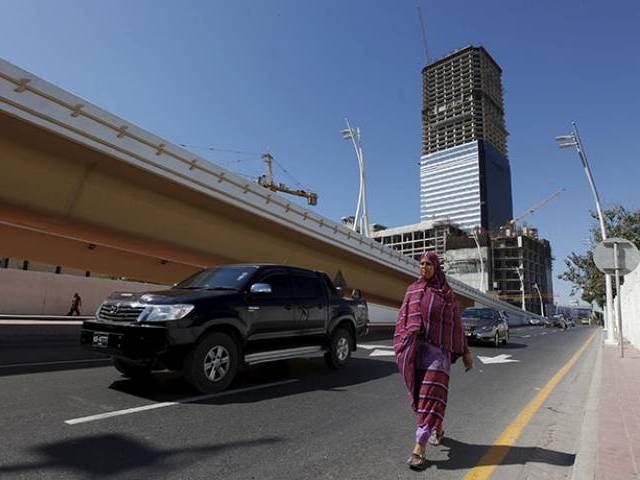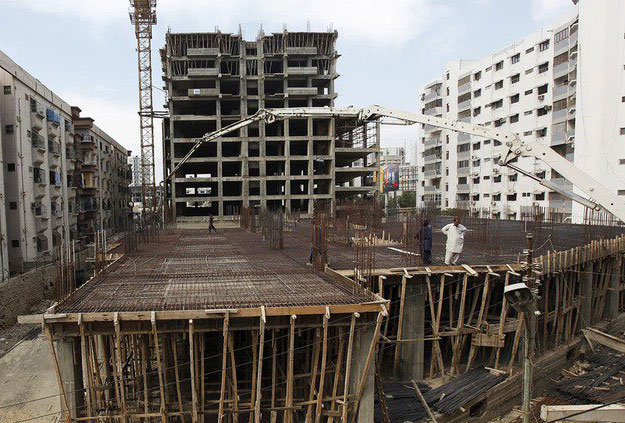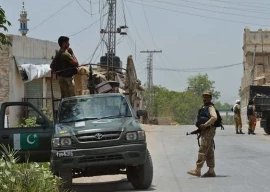
The neighbour had been allowed to illegally construct an apartment on the rooftop of the caller’s house.
No more high-rise buildings: Karachi's construction industry to bear the brunt of SBCA's ban
“Because of the construction, our walls are being damaged and water seeps into our house,” he said. “When we confronted the occupiers, they became violent and are now harassing my wife when she is alone at home. Therefore, I have contacted the ombudsman office.”
I told him to file a complaint with the police and send an application to the Sindh Human Rights Commission. As I spoke to him, I also searched the net for a complaint centre at the Sindh Building Control Authority (SBCA) but failed to find any. The man did not get back but his desperation that morning, when he was obviously unable to get hold of any government office to pursue his cause, kept haunting me for days.
 PHOTO: Express
PHOTO: ExpressThis is just one picture of the distress that Karachi’s unplanned development and expansion has been causing its citizens. The fact that the port city has multiple centres of powers, governance and policy-making and decisions are made completely without citizens’ consultation, also adds to this dilemma.
The surging property prices in Karachi are not only celebrated as a form of government’s success in creating an investment-friendly environment, they are also flaunted as a sign of the city’s popularity. However, housing is not only about investment. It is more about security, peace, and physical and mental well-being. Yet, Karachiites are paying through their nose only to get upset in return.
According to estimates, residents pay Rs6,000 to Rs7,000/feet, for apartments built close to the city centre. Although there is no record available, it is not difficult to imagine the dependence on rented apartments. The average price of Rs10 million to Rs30 million for an apartment does not sound like an affordable sum for a city where the average per capita after-tax income stands at Rs30,846 (according to Numbeo – a database of user contributed data on the cost of living in cities and countries).
Fire breaks out in 19-storey building on II Chundrigar Road
Karachiites are also paying Rs47,750 in rent for a 3-bedroom apartment in areas near the downtown and Rs27,473 for a similar facility outside it. Given these figures and the fact that an average urban household spends over 33 per cent of their income on rent, utilities, and maintenance, the Household Integrated Economic Survey 2013-14 reveals that at least two to three persons from a family, earning an average pay, are required to support it and afford a rented property and other expenses.
 PHOTO: File
PHOTO: FileDrawing from a recommended reading, ‘Karachi: Megacity of Our Times’, on Karachi’s apartment structures in which NED University’s Dr Noman Ahmed has contributed a chapter, and a thesis by Indus Valley student Sidra Hasan Khan, the story of the apartment culture in the port city was never as grim as it is now.
Noting that the apartment culture in Karachi is over a century old – as evident from the old buildings in Saddar and on Burns Road – the chairman of the Architecture and Planning Department points out that apartment blocks in post-Partition Karachi were developed as government housings in FC Area and Martin Quarters during the 60s. Soon with the private sector catching on the trend, apartments started making an appearance in Federal B. Area and Super Highway. Al Azam Square near highway was amongst the first apartment complex catering the lower middle-income group.
During the 60s and the 70s, economic viability was a key consideration by the industry behind the construction of apartments.
Apartments built during the 70s used quality building material and offered reasonable spaces particularly for communal activities. "This was even when the rules and regulations were not imposed. In 1979, Karachi Building and Town Planning Authority was established and strict measures were imposed,” explains Dr Ahmed.
Residents of 354 unsafe buildings in Karachi given eviction notices
As time passed, apartments became a norm in Gulshan-e-Iqbal, Garden, Saddar, Gulistan-e-Jauhar (in the 90s), Shahrah-e-Faisal and some parts of Clifton.
However, the recent conversion of land usage in Karachi is unprecedented. The development is the result of several factors topped by a collaboration of political, bureaucratic and land mafia interest groups, breakdown of traditional joint family structure (that led to the demand for small, independent housing units and supplied bungalow land for building flats), and inflow of remittances and black money that pushed up the housing prices to an unrealistic level.
 PHOTO: Express
PHOTO: ExpressA report presenting SBCA data, from 2008 to 2014, documents 28,096 construction permit applications. Of these, at least 1,377 buildings were officially completed, while 5,737 were demolished (partially or completely) for being illegal. The remaining 18,234 were completed either without permission or not built at all.
Regulatory bodies, for instance, the SBCA, the Defence Housing Authority (DHA) and Cantonment Boards, have been awfully irresponsible and non-consultative in their duties of issuing building permits. This, in turn, massively compromised the land usage in a number of areas in the city. The resulting densification has led to a host of environmental challenges too.
SBCA set to demolish all unapproved building floors in Hyderabad
According to the Sindh Environmental Protection Agency (SEPA) and the Karachi Water and Sewerage Board (KWSB), most commercialisation of roads and approval of buildings in Karachi have been carried out without developing a civic infrastructure or conducting the Environmental Impact Assessment (EIA) or consulting the water board.
The impacts of the unplanned densification are manifested across the city through water shortage, traffic congestion, rapid encroachment and restricted access to public etc. However, in their day-to-day routine, apartment dwellers suffer badly putting their physical and mental well-being at stake.
 PHOTO: File
PHOTO: FileI had a word with apartment dwellers in Gulshan-e-Iqbal, Gulistan-e-Johar, Garden East, FC Area, Clifton and Defence. Nonetheless, the chat cannot be an alternate to a comprehensive research providing a list of their issues, however, their answers can help address some of the challenges they face. A summary of their issues is discussed in this article for generating a debate on the subject.
Encroachment and denial of communal space
Apartment residents in Garden East, Gulistan-e-Johar, and Clifton repeatedly complain of the loss of public space. The ground floor occupants, in connivance with the builders or the management, illegally take over the public access space –the space between the wall of the compound and the wall of the ground floor apartment. An earlier regulation required maintaining a distance of at least 10 to 20 feet between the ground floor apartment and the compound wall. It has been reduced to less than five feet, which now is usually occupied by the people living on the ground floor.
High-rise buildings cannot be counted as one house: CM
New buildings in Karachi have their parking areas in basements while the ground floor is off limits because of the new style encroachment. Many buildings with ground floor parking have seen the construction of illegal flats that further limit their space. This leaves absolutely no room for communal engagements such as weddings and funeral gatherings. Children have no place to play. Even women are forced to remain indoors with little chances of healthy exchange with neighbours. Limited parking space is a perpetual source of contention between residents.
A detailed research study can only reveal the physical and psychological problems such a regime forces upon people in Karachi. However, for Rs7,000 square feet or for 30per cent of household income going into rent, this loss of well-being is costly.
Construction on rooftop
Some buildings, particularly in Clifton, are allowing construction of housing units on their rooftops. Such constructions are, of course, illegal as they were never a part of the original plan. Moreover, the damage it does to the foundation of the structure is one thing, but the state of distress for the top floor residents is also profound, as evident from the New Karachi Town resident’s story at the start of this article.
 PHOTO: Express
PHOTO: ExpressA resident of a 10-floor apartment block in Clifton shared how the building management constructed ‘bachelor pads’ on the rooftops. Typical Pakistani families find it extremely uneasy to live in such environments.
Unavailability of water
Because of water shortage, several apartments in the metropolis get water on a designated time and day, depending on the supply of water from piped sources and water tankers. With members of nuclear families out for work and/or education during the day, managing time to operate the household tanks for filling water is tough.
A couple living in Clifton complained about how they have to get up at 5 am to fill their apartment’s tanks so that they can use it for the rest of the day. Another apartment owner in Defence talked about tussles between apartment residents. Those who are out on full-time jobs refuse to pay the tanker charges on the pretext that their water consumption does not match that of their neighbours with young children.
High rise buildings: the answer to urban slums
Maintenance committees
Building maintenance post-completion rests with either the owners or the Residents Cooperative Society meant to be registered under the Sindh Cooperative Societies Act 1925. This society, in return for a monthly fee, provides maintenance services ensuring the provision of shared utility services and addresses resident’s problems. Now there have been mixed reviews as far as the performance of these committees is concerned. An absence of a democratic dialogue and non-representation of women seems to be two major issues.
While building committees complain of residents not paying their dues, the latter say the former overcharge them for limited services. Some residents also do not find these societies helpful at all for maintaining discipline in terms of parking space or forbidding rowdy residents from disturbing others.
Fire safety
The Karachi Building and Town Planning Regulations-2002 provides for a standpipe system equipped with a fire department approved inlet connection marked ‘Fire Department Connection Stand Pipe. Moreover, the installation of at least one extinguisher on each floor is provided for.
Barring a limited number of high-end apartments, regular apartment buildings in Karachi have not been witnessed to be equipped with any fire safety measures. With swelling encroachment of apartment spaces, and installing of grills at window and balcony openings for security reasons, a Baldia Town factory-like tragedy can lead to an unfathomable loss. It is surprising that the SBCA, responsible for maintaining inspection during the construction of buildings, has sought to overlook such an important detail.
Police discover crystal meth lab inside flat
Construction quality
The SBCA inspects buildings at the time of construction but there is no provision for post-completion inspection in Karachi. Instead, the SBCA expects potential buyers to run their own checks for determining the quality of building material. The building standard becomes evident only a few months after the first occupants move in. Many new apartments in Garden East have had reports of chipped walls and water seepage even before the first shifting took place. As the SBCA does not maintain quality checks, apartment owners are left on their own when they face issues of faulty material or flawed designs.
A number of studies link poor housing quality to bad mental health, underlining depression and a sense of isolation. While one does not see the state taking measures to address the backlog of low-cost housing, its abdication from the key responsibilities of service provision, inspection and dispute resolution is further adding to the distress of the Karachiites, whether they live in their own or rented apartments.
Karachiites remain frustrated with the role of political parties, regulatory bodies and the local and provincial governments for failing to provide the quality of life they deserve. It is unfortunate that this mess has not yet resulted in a concerted agency of citizens to resist the rot. Karachi’s citizens also need to add mobilisation and resistance to their 'To-Do’ list if they ever want to change their reality of buying mental trauma in return for a sizeable chunk of their income.
Zeenia Shaukat is an independent professional. She works on rights-based research, advocacy, capacity building and media communications primarily on issues related to human rights, development, and social justice.




































COMMENTS (6)
Comments are moderated and generally will be posted if they are on-topic and not abusive.
For more information, please see our Comments FAQ